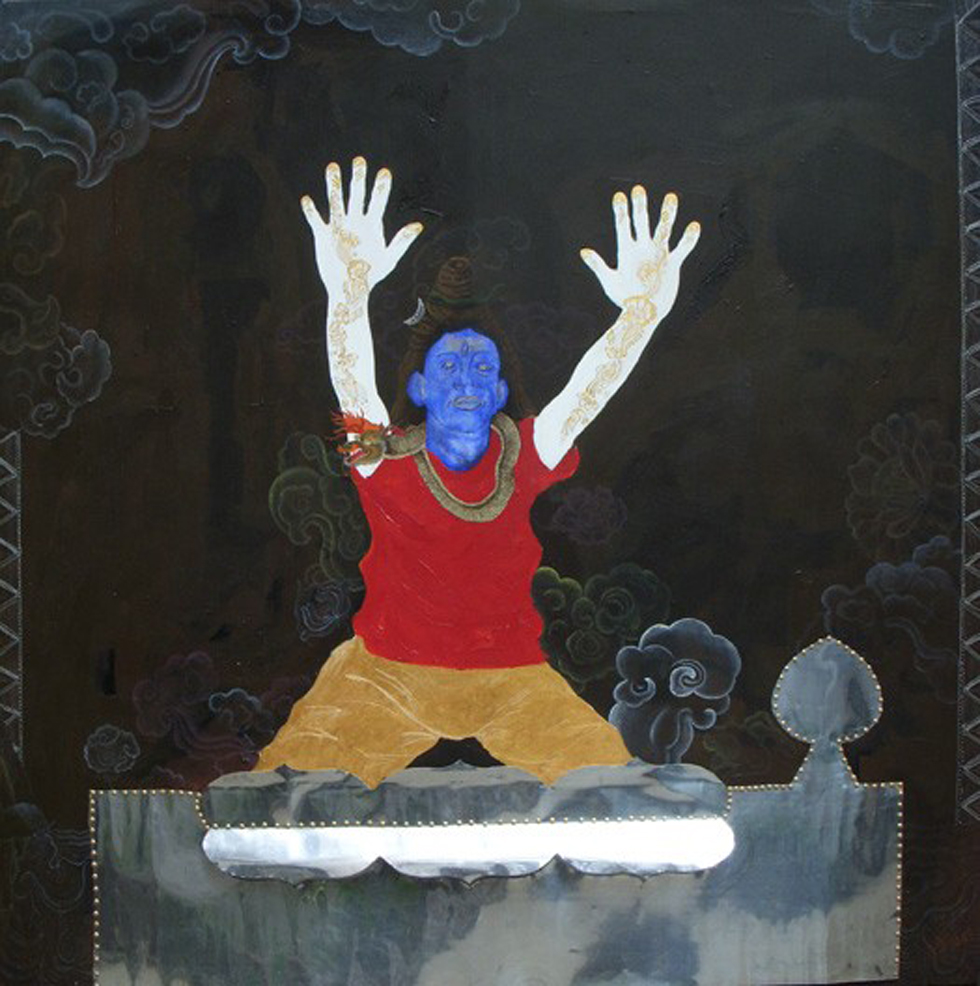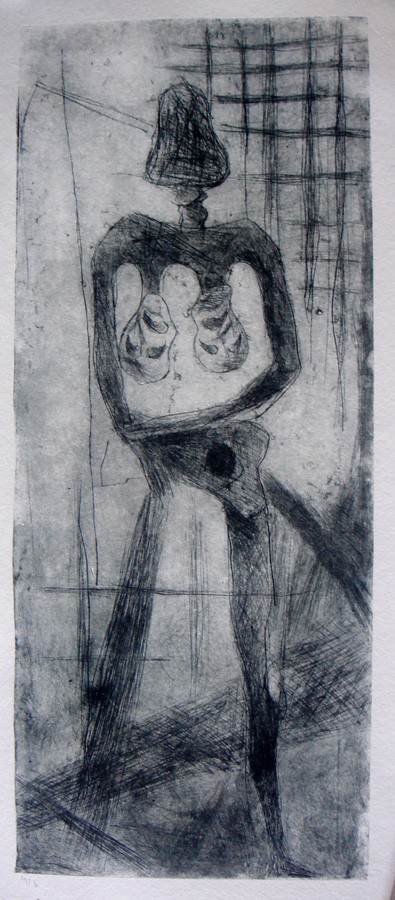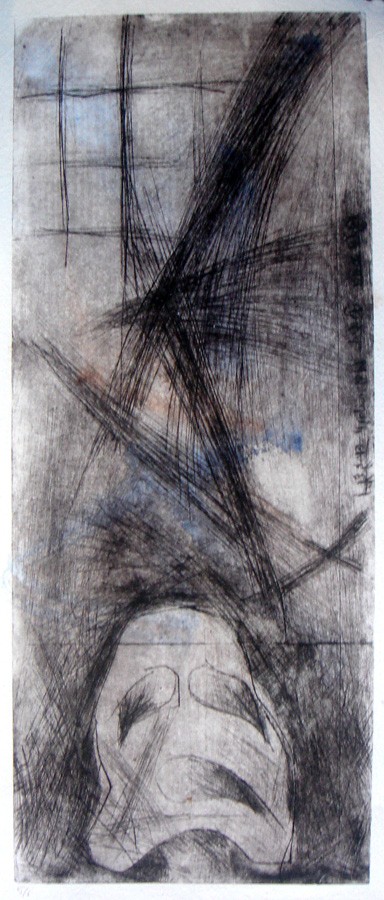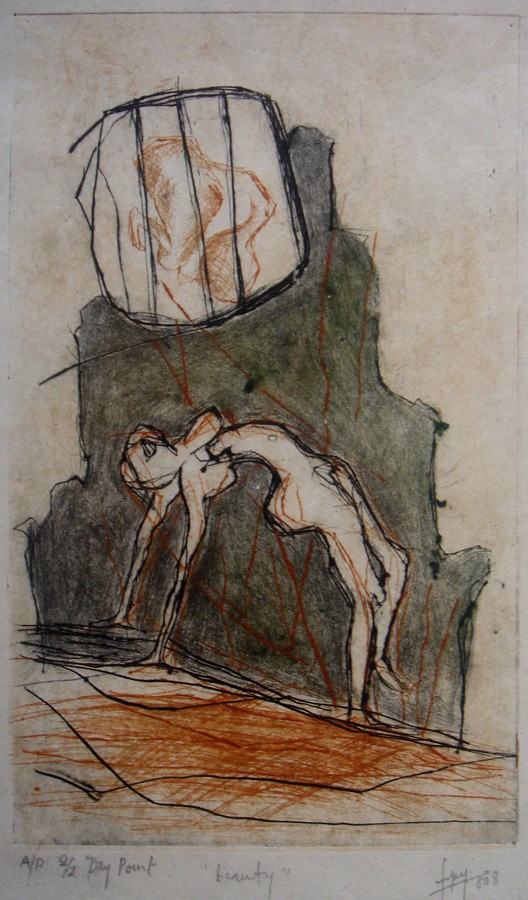Jupiter Pradhan
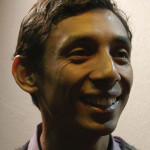
Jupiter Pradhan’s works hint that orientalism has made the eastern intellectuals mannequins. By doing so, the orientalists attempt to prove eastern tradition and knowledge invalid and defunct so that they can impose the hegemony of their so called modernism. According to the artist, actually the west has shared many things from the east. Thus the artist’s implied proposition is eastern artists should go back to their root. In the line of his own philosophy, Jupiter’s works share some aspects of Nepali tradition.
Jupiter Pradhan’s works hint that orientalism has made the eastern intellectuals mannequins. By doing so, the orientalists attempt to prove eastern tradition and knowledge invalid and defunct so that they can impose the hegemony of their so called modernism. According to the artist, actually the west has shared many things from the east. Thus the artist’s implied proposition is eastern artists should go back to their root. In the line of his own philosophy, Jupiter’s works share some aspects of Nepali tradition. By doing so, his artworks covertly question, resist and oppose the western hegemony. Nevertheless, the internal colonization is equally widespread, for so called elites are imposing their power over the underdogs. He gives renewed life to the religious icons, images and symbols.
The multimedia works also depict the struggle between the cultural colonizers and the naïve natives. The ghostly hands lurking from above are attacking the innocent characters. The strings are connected to the innocent characters, the potential mannequins and pulled back and forth by invisible force. The terrorized and agonized characters attempt to free themselves being guided by their own myth and culture. Lotus is a powerful image that symbolizes enlightenment, the assimilation of individual self and the universal spiritual being, in which all the contradictions of the external world are resolved. Traditional Hindu lamp is also recurrent image that symbolizes knowledge, wisdom and light. He does not take traditional established icons as they are but occasionally subverts them with different significances. In next view, his works seem to be political satire with melodramatic and farcical events.
Jupitar Pradhan connects two different cultures, lifestyles and natural surroundings, that is, his own culture in Kathmandu to the Mithila folk art in Terai. His contemporary art techniques come into dialogue to the traditional folk forms. He shares images of plants, leaves, flowers, insects, fish, crabs, Mithila women and even gods and goddesses along with decorative patterns. The human characters are depicted with elongated big eyes and face in profile. The artist reformulates with his own innovation. Despite the different organization, he keeps the constituent parts of the folk art intact without disruption and distortion as in pastiche. The paintings attempt to link the tradition with modernity.
He exploits the decorative lines of the Nepali traditional paintings and recycles the myths. He has also accommodated the motifs of rickshaw painting of Bangladesh in his works. Both Nepali and Bangladeshi features of art have been negotiated in his paintings. The heterogeneous genres and forms like photography, painting and the shiny sheets of rickshaw, the real object of the world (the popular element) are merged together in the single works of art.
In self portraits of Jupiter, the figure appears in the posture of pantomime. And sometimes, he seems to be a mythical character. The artist gets himself reflected in the glittering sheets of rickshaw painting. To be free from the complexity of contemporary society, he puts himself on the circle of lotus in meditating posture. His works have some autobiographical touch and performative dimension.
The artist respects the innocence of the children and makes exquisite toys for them in their own collaboration. His is a humble attempt to free the children from the shackle of modern civilization and the prison-house of the classroom through healing arts. The artist’s obsession with the dolls depicts his nostalgia of his own blissful childhood. Paradoxically, he attempts to unlearn what he has learned considering the primitive situation as the real one. His creative process takes interdisciplinary approach in the sense that he brings together electronic media, music, sculpture, poetry, painting and performance.
Date of birth: 7th Sep. 1977
Nationality: Nepali
Son of: Mr. Victor Pradhan & Mrs. Manju Shree Pradhan.
QUALIFICATION:
I.Sc., Tribhuvan University, Kathmandu, Nepal.
B.F.A. (Painting), Tribhuvan University, Kathmandu, Nepal.
M.F.A. (Painting), University of Development Alternative (UODA), Dhaka, Bangladesh.
SOLO EXHIBITIONS:
– Collective One-Man Art Show, Royal Nepal Academy. (On the Occasion of World Theater Day)
TWO PERSON’S
SHOW: 2009 – An Art Exhibition, La Galerie, Alliance Française, Dhaka, Bangladesh.
EXHIBITIONS & PARTICIPATIONS:
2001-06 – National Art and Craft Exhibition, NAFA, Kathmandu, Nepal.
1998-08- Several Group Art Exhibitions in different galleries of Kathmandu and Pokhara, Nepal. (J Art Gallery, Everest Art Gallery, Srijana Art Gallery, Gallery 9, NAC, NAFA.)
2002 – Group Art Exhibition, Darjeeling, India.
2003 – Group Art Exhibition, Sikkim, India.
2004 – Camel Art Exhibition, Kolkatta, India.
2005 – Art Tour, Kathmandu, Nepal-Banaras, India.
2006 – The Out Come Exhibition of the Khulla Dhoka Art Workshop, NAFA, Kathmandu, Nepal.
– The out come Exhibition of the collaborative workshop with Mithila Art and Contemporary art (Nepal & Bangladesh), Siddhartha Art Gallery, Kathmandu, Nepal.
2007 – The out come Exhibition of the collaborative workshop with Mithila art and Contemporary art (Nepal & Bangladesh), Gallerikaya, Dhaka, Bangladesh.
– Exhibition of Britto Regional Residency ‘007, Drik Gallery, Dhaka, Bangladesh.
2008 – Annual Exhibition UODA, Dhaka, Bangladesh.
– Exhibition of Printmaking Workshop, Gallery Chitrak, Dhaka, Bangladesh.
– The out come Exhibition of the collaborative workshop with Mithila art and Contemporary art (Nepal & Bangladesh), Copenhagen, Denmark.
– Triangular Art Network’s Exhibition by Sutra, Kathmandu, Nepal.
– 13th Asian Biennale 2008, Dhaka, Bangladesh.
2009 – An Exhibition of Contemporary art organized by The SAARC Women’s Association, Dhaka, Bangladesh. (At Radisson Water Garden Hotel, Dhaka)
Video Art:
2009 – ‘My Lord’, 1.55 min. long. (International Video Art Show ’09, Hotel Manang, Kathmandu, Nepal. By; Space A, for alternative art practice.)
PERFORMANCE:
– Worship of Power, Regional Residency ‘007, Drik Gallery, Dhaka, Bangladesh.
– Mannequin Civilization, Little Movement in Town, Performance Art Event, Kathmandu, Nepal.
WORKSHOP/RESIDENCY:
1998 – 2009 several local and international workshop in Nepal, Bangladesh and India including;
– Illustrators’ Workshop (3 days), United Mission to Nepal, Thapathali, Kathmandu, Nepal (1998).
– Art Workshop, Darjeeling, India (2002).
– Art Workshop, Sikkim, India (2003).
– 7 Days long Art Workshop by Sutra Art Foundation at Osho Tapoban (2003).
– 10 Days long Art Workshop by Sutra Art Foundation at Osho Tapoban (2005).
– Khulla Dhoka Art Workshop, Siddhartha Art Gallery (2006).
– International Artist Workshop (10 days) by Sutra Art Foundation at Patan, Nepal (2006).
– Collaboration with Mithila Art (20Days) by Bindu at JWDC, Janakpur, Nepal (2006).
– Britto Regional Residency ‘007, Dhaka, Bangladesh (2007).
– Print Making Workshop, UODA, Dhaka, Bangladesh (2008).
– Short Documentary Video Art Workshop, Space A (2009).
WORKED:
- Founder, Space A, for alternative art practice.
- Founder Member, FineArtnepal.com.
- Founder, Bindu; A space for Artists.
- Founder & Executive Member (2006-07), SchEMS Public School.
- Joint Secretary F.S.U., Fine Art Campus. (1999-01)
- Executive Member, Artist’s Society of Nepal. (2001-04)
- Member of National Organizing Committee, International Children’s Peace Mural Painting Exhibition, Kids’ Guernica 2000, Nepal.
- Art teacher, Mount Gauri Shankar School & British Gurkha Academy. (ex)
AWARDS:
2000 – 1st Prize, Red Cross, Nepal.
2008 – Honorable Award, UODA, Dhaka, Bangladesh.
